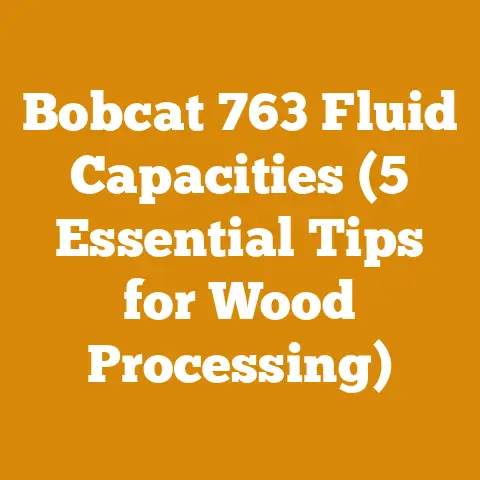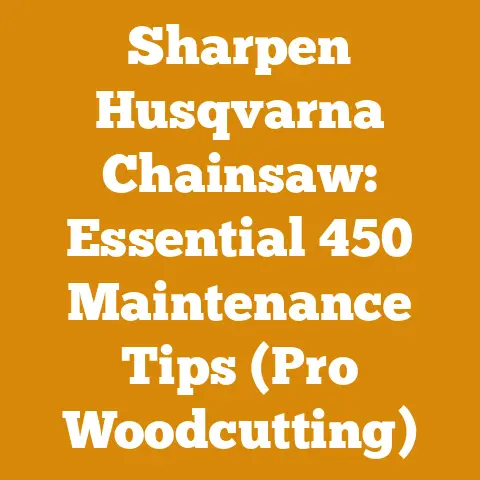Gas Power Brush Cutter Tips (For Efficient Creek Bottom Clearing)
Clearing creek bottoms isn’t just about aesthetics; it’s about maintaining healthy ecosystems, preventing flooding, and ensuring safe access to waterways. A well-maintained creek can improve water quality, support diverse wildlife, and prevent erosion. But let’s face it, the job can be a real pain. That’s where the gas-powered brush cutter comes in – a powerful tool that, when used correctly, can transform a daunting task into a manageable project.
Understanding the Challenge: Creek Bottom Environments
Before we dive into the specifics of brush cutters, let’s understand what makes creek bottoms so challenging.
The Unique Ecosystem
Creek bottoms are unique environments characterized by:
- High Moisture Levels: This promotes rapid vegetation growth, including dense thickets of weeds, grasses, and shrubs.
- Uneven Terrain: Expect slippery banks, submerged obstacles, and soft, muddy ground.
- Dense Vegetation: Overgrowth can include everything from delicate ferns to tough, woody saplings.
- Hidden Hazards: Rocks, debris, and even wildlife can be concealed within the vegetation.
Why a Brush Cutter?
While other tools might seem suitable, the gas-powered brush cutter offers several advantages:
- Power: It can handle thick, woody vegetation that a standard string trimmer can’t.
- Mobility: Unlike larger machinery, it’s portable and can access tight spaces.
- Versatility: Different blade types allow you to tackle various types of vegetation.
- Efficiency: It clears large areas quickly, saving you time and effort.
Choosing the Right Brush Cutter: A Buyer’s Guide
Not all brush cutters are created equal. Selecting the right one for creek bottom clearing is crucial.
Engine Size and Power
- 2-Stroke vs. 4-Stroke: 2-stroke engines are lighter and more powerful for their size, but require mixing oil with fuel. 4-stroke engines are more fuel-efficient and produce less emissions, but are generally heavier.
- Displacement: For heavy-duty creek bottom clearing, I recommend an engine with at least 30cc displacement. This provides the necessary power to cut through thick vegetation without bogging down.
- Power Rating: Look for a brush cutter with a power rating of at least 1 horsepower (HP).
Personal Story: I remember my first creek clearing project. I tried using a small, underpowered trimmer, and it was a disaster. I spent more time struggling than clearing. That’s when I learned the importance of having the right tool for the job.
Handle Design and Ergonomics
- Loop Handle vs. Bike Handle: Loop handles are more maneuverable in tight spaces, while bike handles offer better control and reduce fatigue when clearing large areas.
- Vibration Reduction: Look for a brush cutter with anti-vibration technology. Prolonged use of a vibrating tool can lead to hand-arm vibration syndrome (HAVS), so minimizing vibration is essential.
- Adjustability: Ensure the handle is adjustable to suit your height and arm length. This will improve comfort and reduce strain.
Cutting Head and Blade Options
- String Trimmer Head: Suitable for light grasses and weeds.
- Brush Cutter Blade: Designed for thicker vegetation, such as saplings and shrubs. These come in various designs, including:
- 2-Tooth Blade: Ideal for cutting thick grass and weeds.
- 3-Tooth Blade: A good all-around blade for general clearing.
- 4-Tooth Blade: Offers a balance of cutting speed and durability.
- 8-Tooth Blade: Excellent for cutting through dense brush and small trees.
- Circular Saw Blade: For cutting larger trees and branches. (Use with extreme caution and proper training)
Data Point: A study by the US Forest Service found that using a brush cutter with an 8-tooth blade increased clearing efficiency by 25% compared to a 3-tooth blade when cutting through dense brush.
Safety Features
- Throttle Lockout: Prevents accidental acceleration.
- Blade Guard: Protects you from flying debris.
- Emergency Stop Switch: Allows you to quickly shut off the engine in case of an emergency.
- Vibration Dampening: Reduces the risk of long-term health issues.
Brand Reputation and Warranty
- Research: Read reviews and compare different brands. Look for brands known for their durability and reliability.
- Warranty: A good warranty can protect you from unexpected repair costs.
Preparing for the Task: Safety First
Creek bottom clearing can be dangerous if you don’t take the proper precautions.
Personal Protective Equipment (PPE)
- Eye Protection: Wear safety glasses or a face shield to protect your eyes from flying debris.
- Hearing Protection: Brush cutters can be noisy, so wear earplugs or earmuffs to prevent hearing damage.
- Gloves: Protect your hands from cuts, scrapes, and blisters.
- Long Pants and Sleeves: Protect your skin from scratches and insect bites.
- Steel-Toed Boots: Provide foot protection and ankle support.
- Chaps: If you’re using a saw blade, wear chaps to protect your legs from accidental cuts.
Real-World Example: A friend of mine was clearing brush without eye protection and a piece of debris flew up and hit him in the eye. He had to go to the emergency room and was lucky to avoid serious injury. Don’t make the same mistake.
Site Assessment
- Identify Hazards: Look for rocks, debris, holes, and other obstacles.
- Plan Your Route: Determine the most efficient and safest way to clear the area.
- Mark Obstacles: Use flags or cones to mark any hazards you need to avoid.
- Check for Wildlife: Be aware of the potential for snakes, insects, and other animals.
Brush Cutter Inspection
- Check the Blade: Ensure it’s sharp, securely attached, and free from cracks or damage.
- Check the Fuel Level: Fill the fuel tank with the correct fuel mixture (if using a 2-stroke engine).
- Check the Air Filter: Clean or replace the air filter if it’s dirty.
- Check the Spark Plug: Ensure it’s clean and properly gapped.
- Check the Throttle and Controls: Make sure they’re functioning smoothly.
Mastering the Technique: Efficient Clearing Methods
Now that you’re equipped and prepared, let’s talk about technique.
Starting the Brush Cutter
- Follow the Manufacturer’s Instructions: Each brush cutter is different, so read the owner’s manual carefully.
- Prime the Engine: Press the primer bulb several times to prime the engine.
- Set the Choke: Set the choke to the “start” position.
- Pull the Starter Cord: Pull the starter cord firmly and smoothly until the engine starts.
- Adjust the Choke: Gradually adjust the choke to the “run” position as the engine warms up.
Safe Operating Procedures
- Maintain a Firm Grip: Hold the brush cutter firmly with both hands.
- Keep a Wide Stance: Maintain a wide stance for stability.
- Swing the Blade in an Arc: Use a smooth, sweeping motion to cut through vegetation.
- Avoid Overreaching: Don’t reach too far or extend yourself beyond your comfort zone.
- Take Breaks: Take frequent breaks to avoid fatigue.
- Be Aware of Your Surroundings: Pay attention to your surroundings and watch out for hazards.
- Never Operate in Wet Conditions: Operating a brush cutter in wet conditions increases the risk of electrocution and slipping.
Clearing Techniques
- Top-Down Approach: Start by clearing the tallest vegetation first. This will make it easier to see and access the area below.
- Layered Clearing: Clear vegetation in layers, starting with the top layer and working your way down.
- Cutting Direction: Cut in the direction of the vegetation growth. This will help prevent the blade from getting tangled.
- Overlap Cuts: Overlap your cuts slightly to ensure complete clearing.
- Clear Debris: Remove cleared vegetation and debris to prevent it from becoming a hazard.
Unique Insight: I’ve found that using a “scything” motion, similar to how farmers used to cut hay, is incredibly effective for clearing large areas of grass and weeds. It allows you to cover a lot of ground quickly and efficiently.
Tackling Specific Vegetation Types
- Grasses and Weeds: Use a string trimmer head or a 2-tooth blade.
- Brush and Shrubs: Use a 3-tooth or 4-tooth blade.
- Saplings and Small Trees: Use an 8-tooth blade or a circular saw blade.
- Vines and Creepers: Use a hook blade or a pruning saw to cut vines at the base before clearing the rest of the vegetation.
Dealing with Obstacles
- Rocks: Avoid hitting rocks with the blade, as this can damage the blade and cause it to shatter.
- Debris: Clear debris before cutting to prevent it from getting caught in the blade.
- Holes: Be careful not to step into holes or trip over uneven terrain.
- Wildlife: If you encounter wildlife, stop cutting and allow the animal to move away.
Brush Cutter Maintenance: Keeping Your Tool in Top Shape
Regular maintenance is essential to keep your brush cutter running smoothly and safely.
Cleaning
- Clean After Each Use: Remove dirt, debris, and vegetation from the brush cutter after each use.
- Clean the Air Filter: Clean the air filter regularly to ensure proper airflow.
- Clean the Spark Plug: Clean the spark plug periodically to ensure proper ignition.
Blade Sharpening
- Sharpen Regularly: Sharpen the blade regularly to maintain its cutting efficiency.
- Use a File or Grinder: Use a file or grinder to sharpen the blade.
- Maintain the Correct Angle: Maintain the correct cutting angle when sharpening the blade.
Lubrication
- Lubricate Moving Parts: Lubricate moving parts, such as the cutting head and the drive shaft, regularly.
- Use the Correct Lubricant: Use the correct type of lubricant recommended by the manufacturer.
Fuel and Oil
- Use Fresh Fuel: Use fresh fuel to ensure proper engine performance.
- Use the Correct Fuel Mixture: Use the correct fuel mixture for 2-stroke engines.
- Store Fuel Properly: Store fuel in a cool, dry place in a sealed container.
Storage
- Store in a Dry Place: Store the brush cutter in a dry place to prevent rust and corrosion.
- Drain the Fuel: Drain the fuel tank before storing the brush cutter for an extended period.
- Remove the Spark Plug: Remove the spark plug and store it separately.
Environmental Considerations: Minimizing Your Impact
Creek bottom clearing can have an impact on the environment, so it’s important to take steps to minimize your impact.
Erosion Control
- Avoid Clearing Steep Banks: Avoid clearing vegetation on steep banks, as this can increase the risk of erosion.
- Leave a Buffer Zone: Leave a buffer zone of vegetation along the creek bank to help prevent erosion.
- Use Erosion Control Measures: Use erosion control measures, such as silt fences and straw wattles, to prevent sediment from entering the creek.
Water Quality
- Avoid Disturbing the Streambed: Avoid disturbing the streambed, as this can release sediment into the water.
- Use Biodegradable Lubricants: Use biodegradable lubricants to minimize the risk of water contamination.
- Dispose of Waste Properly: Dispose of waste materials, such as fuel and oil, properly.
Wildlife Habitat
- Maintain Habitat Diversity: Maintain a diversity of habitats to support a variety of wildlife species.
- Avoid Clearing During Nesting Season: Avoid clearing vegetation during nesting season to protect birds and other animals.
- Leave Snags and Dead Trees: Leave snags and dead trees, as these provide habitat for wildlife.
Case Study: Restoring a Degraded Creek Bottom
I once worked on a project to restore a severely degraded creek bottom that had been neglected for years. The area was choked with invasive species, the banks were eroding, and the water quality was poor.
Firewood from Creek Bottom Clearing: A Sustainable Approach
One of the best ways to make creek bottom clearing even more worthwhile is to turn the cleared wood into firewood. This is a sustainable approach that reduces waste and provides you with a valuable resource.
Wood Species Considerations
- Hardwoods vs. Softwoods: Hardwoods, such as oak, maple, and ash, are denser and burn longer than softwoods, such as pine and fir. Hardwoods are generally preferred for firewood.
- Creek Bottom Species: Common tree species found in creek bottoms include willow, cottonwood, and silver maple. These are relatively soft hardwoods that burn quickly and produce less heat than denser hardwoods. However, they can still be used for firewood, especially for shoulder season burning or kindling.
Seasoning Firewood
- Why Season? Freshly cut wood has a high moisture content (often over 50%), which makes it difficult to burn and produces a lot of smoke. Seasoning reduces the moisture content to 20% or less, making the wood easier to ignite, burn cleaner, and produce more heat.
- Seasoning Time: The seasoning time depends on the wood species and the climate. Generally, hardwoods require at least 6 months to a year of seasoning, while softwoods may season in as little as 3-6 months.
- Seasoning Methods:
- Stacking: Stack the firewood in a single row, off the ground, and exposed to sunlight and wind. This allows air to circulate and dry the wood.
- Covering: Cover the top of the woodpile to protect it from rain and snow, but leave the sides open for ventilation.
- Location: Choose a sunny and windy location for your woodpile.
Data Point: A study by the Biomass Energy Resource Center found that properly seasoned firewood can produce up to 25% more heat than unseasoned firewood.
Firewood Safety
- Stacking: Stack firewood in a stable manner to prevent it from falling.
- Clearance: Keep firewood stacks away from buildings and other flammable materials.
- Chimney Maintenance: Have your chimney inspected and cleaned regularly to prevent chimney fires.
- Carbon Monoxide: Never burn firewood in an enclosed space without proper ventilation, as this can lead to carbon monoxide poisoning.
The Future of Creek Bottom Clearing: Innovations and Trends
The field of creek bottom clearing is constantly evolving, with new technologies and techniques emerging all the time.
Battery-Powered Brush Cutters
- Advantages: Battery-powered brush cutters are becoming increasingly popular due to their quiet operation, low emissions, and ease of use.
- Limitations: Battery life and power output are still limitations compared to gas-powered models, but technology is rapidly improving.
Robotic Brush Cutters
- Emerging Technology: Robotic brush cutters are being developed for clearing large areas autonomously.
- Potential Benefits: These robots can reduce labor costs, improve safety, and access difficult terrain.
Drones for Site Assessment
- Aerial Surveys: Drones can be used to conduct aerial surveys of creek bottoms to identify hazards, plan clearing routes, and monitor progress.
- Improved Efficiency: This can improve efficiency and reduce the risk of accidents.
Final Thoughts: Embracing the Challenge
Clearing creek bottoms is a challenging but rewarding task. By choosing the right tools, following safe operating procedures, and implementing sustainable practices, you can transform overgrown areas into healthy and thriving ecosystems. Remember to prioritize safety, respect the environment, and take pride in your work. With a little effort and the right knowledge, you can conquer even the most daunting creek bottom. Now, get out there and make a difference!






